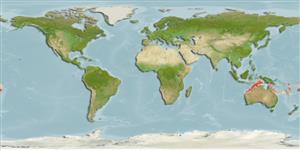Environment: milieu / climate zone / depth range / distribution range
Ecologia
marinhas demersal; intervalo de profundidade 73 - 210 m (Ref. 5222). Tropical; 1°N - 23°S, 115°E - 177°W (Ref. 5222)
Eastern Indian Ocean: Western Australia. Eastern Central Pacific: American Samoa and the Phoenix Islands.
Tamanho / Peso / Idade
Maturity: Lm ? range ? - ? cm
Max length : 71.0 cm TL macho/indeterminado; (Ref. 125599); peso máx. publicado: 4.5 kg (Ref. 125599)
Espinhos dorsais (total): 11; Raios dorsais (total): 16-17; Espinhos anais 3; Raios anais : 8. Preopercle angle with 2 - 4 distinctly enlarged serrae; upper edge of the operculum straight or nearly so; nostrils small, subequal; maxilla extends to below rear half of the eye. Color is pale brownish gray with yellow or golden brown spots on the head, nape and chest. A row of dark yellowish brown spots along the margin of the soft dorsal and anal fins and the rear edge of the caudal fin. Pelvic fins with yellowish brown and whitish streaks and a few yellowish brown spots distally. Further characterized by body depth contained 2.7-3.4 times in SL; head length 2.4-2.7 times in SL; flat to convex interorbital area; 2-4 distinctly enlarged serrae at preoopercle angle; upper edge of operculum nearly straight or straight; small anterior and posterior nostril, subequal; maxilla extends to below rear half of eye; 2 rows of teeth on midlateral part of lower jaw (Ref. 89707).
Nothing has been published on the biology of this rare species. The apparent rarity of this species is probably a result of its deep-water habitat and the fact that it was only recently described as a new species.
Ciclo de vida ou comportamento de acasalamento
Maturidade | Reprodução | Desova | Ovos | Fecundidade | Larvas
Heemstra, P.C. and J.E. Randall, 1993. FAO Species Catalogue. Vol. 16. Groupers of the world (family Serranidae, subfamily Epinephelinae). An annotated and illustrated catalogue of the grouper, rockcod, hind, coral grouper and lyretail species known to date. Rome: FAO. FAO Fish. Synop. 125(16):382 p. (Ref. 5222)
Status na Lista Vermelha da UICN (Ref. 130435)
Ameaça para os humanos
Harmless
Uso pelos humanos
Pescarias: sem interesse
Mais informação
Nomes comunsSinônimosMetabolismoPredadoresEcotoxicologiaReproduçãoMaturidadeDesovaAgregação de desovaFecundidadeOvosDesenvolvimento dos ovos
ReferênciasAquaculturaPerfil para aquaculturaEstirpesGenéticaElectrophoresesHereditariedadeDoençasProcessamentoNutrientsConversão de massa
ColaboradoresFotosStamps, Coins Misc.SonsCiguateraVelocidadeTipo de nataçãoÁrea branquialOtólitosCérebrosVisão
Ferramentas
Relatórios especiais
Baixar XML
Fontes da internet
Estimates based on models
Preferred temperature (Ref.
123201): 21.4 - 25.3, mean 23.3 °C (based on 34 cells).
Índice de diversidade filogenética (Ref.
82804): PD
50 = 0.5000 [Uniqueness, from 0.5 = low to 2.0 = high].
Bayesian length-weight: a=0.00955 (0.00556 - 0.01641), b=3.00 (2.86 - 3.14), in cm total length, based on LWR estimates for this species & Genus-body shape (Ref.
93245).
Nível Trófico (Ref.
69278): 3.9 ±0.5 se; based on size and trophs of closest relatives
Resiliência (Ref.
120179): Baixo, tempo mínimo de duplicação da população 4,5 - 14 anos (Preliminary K or Fecundity.).
Fishing Vulnerability (Ref.
59153): Moderate to high vulnerability (48 of 100).
Nutrients (Ref.
124155): Calcium = 122 [54, 276] mg/100g; Iron = 1.04 [0.50, 2.42] mg/100g; Protein = 17.6 [15.9, 19.1] %; Omega3 = 0.253 [0.133, 0.476] g/100g; Selenium = 58.1 [28.2, 130.8] μg/100g; VitaminA = 68.7 [16.7, 285.5] μg/100g; Zinc = 1.46 [0.92, 2.38] mg/100g (wet weight);
